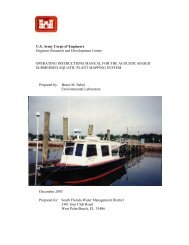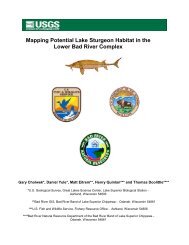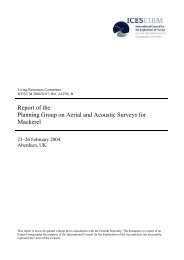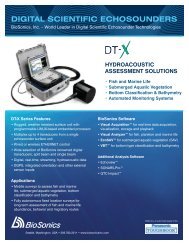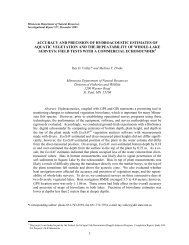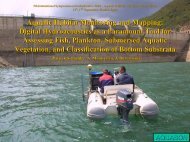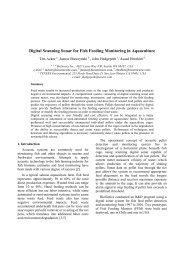Target Strength of Southern Resident Killer Whales ... - BioSonics, Inc
Target Strength of Southern Resident Killer Whales ... - BioSonics, Inc
Target Strength of Southern Resident Killer Whales ... - BioSonics, Inc
You also want an ePaper? Increase the reach of your titles
YUMPU automatically turns print PDFs into web optimized ePapers that Google loves.
Code:46.2008-final-Feb9<br />
I. INTRODUCTION<br />
Prototype marine hydrokinetic energy devices are in the process <strong>of</strong> being deployed in coastal waters to<br />
evaluate their performance and any environmental consequences <strong>of</strong> operation. No tidal power generating<br />
devices are currently deployed in the United States. A Federal Energy Regulatory Commission<br />
preliminary permit has been granted to Snohomish County Public Utility District No. 1 to deploy two<br />
tidal turbines built by OpenHydro (Dublin, Ireland) at a site in Admiralty Inlet in Washington’s Puget<br />
Sound to study their operation over a 5-year period. A criterion for final approval for deployment <strong>of</strong> tidal<br />
turbines by regulatory authorities is demonstration <strong>of</strong> capability to manage the risk <strong>of</strong> injury to killer<br />
whales from strike by moving turbine blades. Pacific Northwest National Laboratory researchers are<br />
designing and testing a prototype <strong>of</strong> a marine mammal alert system (MMAS) for detecting the presence<br />
<strong>of</strong> killer whales in the immediate vicinity <strong>of</strong> tidal turbines. The system will inform tidal turbine operators<br />
about the presence <strong>of</strong> the killer whales to facilitate shut down <strong>of</strong> the turbines when there is high risk <strong>of</strong><br />
collision <strong>of</strong> the whale with the operating turbine. Both passive and active monitoring systems are being<br />
considered for the MMAS. The passive monitoring system is being developed by modifying an energybased<br />
juvenile salmon acoustic telemetry system (McMichael et al., 2010; Deng et al. 2011; Weiland et<br />
al., 2011). Several commercially available sonars are being evaluated for the active monitoring system.<br />
An object in water with acoustic impedance different from water scatters a portion <strong>of</strong> acoustic energy<br />
incident from an active acoustic source back toward the insonifying acoustic system or other receivers<br />
within range. The ratio <strong>of</strong> energy incident on the object to that backscattered from the object is defined as<br />
the target strength (TS) for the object. With the exception <strong>of</strong> a sphere <strong>of</strong> uniform composition, the target<br />
strength <strong>of</strong> an object, such as a fish or whale, is a complex function <strong>of</strong> the shape <strong>of</strong> the object and its<br />
orientation to the insonifying sonar system. <strong>Target</strong> strength is a parameter in the sonar equation and is<br />
required for the design <strong>of</strong> a sonar system to optimize design for detection <strong>of</strong> the targets <strong>of</strong> interest. The<br />
2



